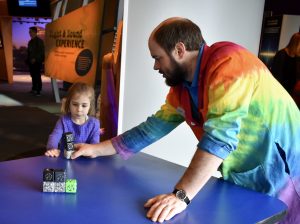Materials to Collect
- Bucket with a handle
- Marble
- Big bowl
Try it!
Place your marble into your big bowl. Keep the bottom of the bowl on the table while moving the bowl quickly in a big circle. Imagine you are drawing a circle on your table using the bottom of the bowl. What do you notice happening to the marble?
Next, try putting an object in your bucket, (or water if you are daring), and swing the bucket up over your head. Imagine your arm is a windmill and swing it in a straight-arm circle as fast as you can.
What is the Science?
Centripetal force is a “center-seeking force.” Simply, it is the force that keeps an object traveling in a circle. Think of the marble rolling around the inside of the bowl. Without the bowl, the marble would fly off in a straight line. The bowl applies a force to the marble, keeping it traveling in a circular path. This is the centripetal force. When you swing your bucket in a circle, the bottom of the bucket is applying the centripetal force.
Centripetal force is all around you. The sides of your washing machine apply a force to keep all of your clothes traveling in a circle, instead of flying across the room. The tiny holes in the drum of your washing machine rely on the principle of centripetal force to dry your clothes. Your clothes are too big to go through these holes and are held in the drum of your washing machine by the centripetal force exerted by the walls. However, droplets of water are smaller than the holes. They can fit through those little holes which means they are not subject to the centripetal force of the walls of the washing machine drum. They fly off in a straight line into the holes and out of your clothes!
Ask Your Young Scientists
- What do you think would happen if we swing our bucket really slowly?
- What would happen if we stop the bucket when it is directly above our heads?
- What do you think would happen if our object was heavier? Or lighter?
More to Explore
Try different types and weights of objects in your bucket. Look for examples of centripetal force in your everyday life. You might find examples when you are in the car, or using kitchen appliances, or even looking up at our orbiting moon.
We want to see what you try at home. Share your creation with us on social media by using the #ScienceAtPlay and tagging @CTScienceCenter.

Nick Villagra is a STEM Educator at the Connecticut Science Center, responsible for developing and delivering science experiences, including classroom lab programs, stage shows, and vacation camps. Nick holds a Bachelor’s of Science in Engineering from Swarthmore College. and has been a speaker at the New England Museum Association conference. Always looking to put a unique stamp on the Science Center’s offerings, Nick enjoys incorporating custom-designed 3D printed materials for students to interact with.




